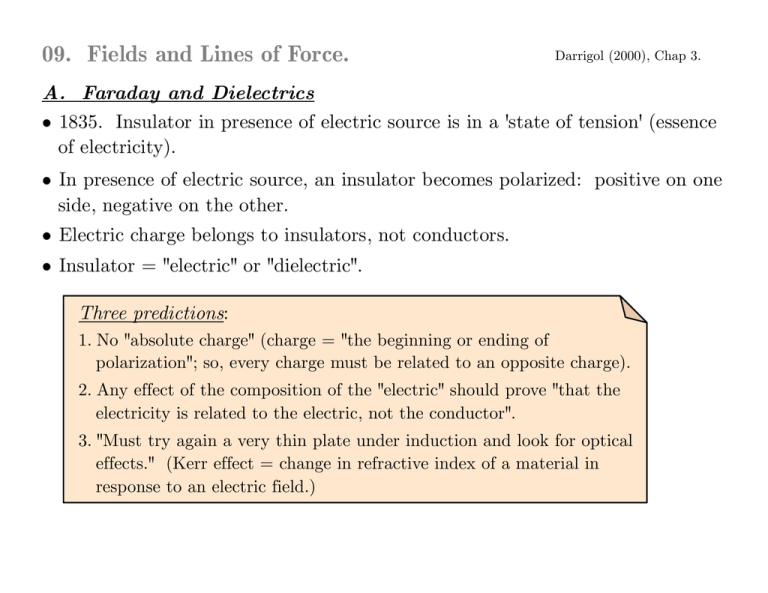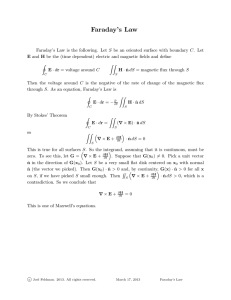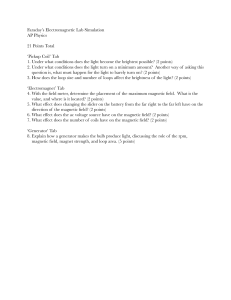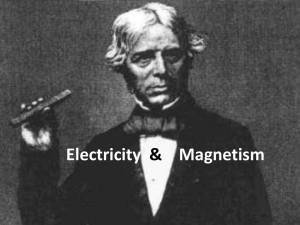09. Fields and Lines of Force.
advertisement

09. Fields and Lines of Force. Darrigol (2000), Chap 3. A. Faraday and Dielectrics • 1835. Insulator in presence of electric source is in a 'state of tension' (essence of electricity). • In presence of electric source, an insulator becomes polarized: positive on one side, negative on the other. • Electric charge belongs to insulators, not conductors. • Insulator = "electric" or "dielectric". Three predictions: 1. No "absolute charge" (charge = "the beginning or ending of polarization"; so, every charge must be related to an opposite charge). 2. Any effect of the composition of the "electric" should prove "that the electricity is related to the electric, not the conductor". 3. "Must try again a very thin plate under induction and look for optical effects." (Kerr effect = change in refractive index of a material in response to an electric field.) Prediction 1: No "absolute charge". • Consider a hollow conductor: If charge derives from the beginning or ending of polarization, there can be no charge inside a conductor, since conductors do not exhibit polarization. • 1835. Inside bottom of copper boiler carries no charge, no matter how electrified the boiler globally is. • 1836. Builds a 12 foot conducting cube with wood, copper, wire, paper, and tin foil and "lived in it" to check internal electric state. • No electricity in "Faraday cage"! • Conclusion: Induction is "illimitable": no global loss of power along a polarized dielectric. • Or: Absolute charge does not exist, insofar as all charge is sustained by induction and is related to another, opposite charge. Prediction 2: Dependence of induced charge on type of dielectric. • Consider device containing two concentric brass spheres. ! Internal sphere connected to conducting ball through brass rod. ! Solid, liquid, or gaseous dielectric can be placed between spheres. • Now: Construct two such devices, A and B. ! Charge A and measure "tension" ("degree of charge") V0. ! Bring A into contact with B and measure tensions, call them V1, V2, with V1 = V2 ≡ V12. ! If A, B are filled with different dielectrics, they have different "capacities for electric induction", call them C1, C2. • Suppose: Charge = CV. • Then: Original charge of A is C1V0 = (C1 + C2)V12. • Or: V0 = [(C1 + C2)/C1]V12. • So: (V0 − V1)/V2 = (V0 − V12)/V12 = C2/C1. • In words: "The ratio of the fall of tension (V0 − V1) of A to the gain in tension V2 of B is the ratio C2/C1 of their capacities. • Note: When carrying ball with charge touches top of grounded fixed ball B, B can acquire charge. • Since carrying ball is small, and B is grounded, charge must come from insultated stem below B. • Which means: Induction can occur in "curved lines" around B. • Faraday: Evidence that induction is an action between continguous particles (direct action-at-a-distance would be linear). "[Induction in dielectrics]... is the essential principle for the development of electricity." • "Electric charge was a spatial discontinuity of induction, and the electric current was a variation in time or a propagation of induction." (Darrigol, pg. 91.) How to visualize electric induction • 1836-37 experiments with electric discharges in gases. Introduction of "lines of electric induction". "The description of the current as an axis of power, which I have formerly given, suggests some similar general expression for the forces of quiescent electricity. Lines of electric tension might do; and though I shall use the terms Pos. and Neg., by them I merely mean the termini of such lines." • But: Lines of electric induction are "imaginary": "[They are] a temporary conventional mode of expressing the direction of the power in cases of induction... [I focus on] the manner in which the electric forces are arranged in the various phenomena generally... without committing myself to any opinion as to the cause of electricity." • Moreover: "The theory of induction which I am stating does not pretend to decide whether electricity be a fluid or fluids, or a mere power or condition of recognized matter." • However: Lines of electric induction figure in causal explanations of electrical phenomena. • "...Faraday imagined a mechanical tension along, and a mutual repulsion between the lines [of electric induction]. The repulsion explained induction in curved lines and the concentrating power of conducting edges. The tension accounted for the motive forces between charged bodies." (Darrigo, pg. 92.) • "Accordingly, two charged bodies could only attract each other to the extent of their connection by lines of induction." Misunderstandings of critics 1. No absolute charges exist. • Means: A charge is the starting point of an induction that ends somewhere else as an opposite charge. • Does not mean: Isolated charged particles do not exist. 2. Induction in curved lines. • Critics think: A acts on B only through C. • Faraday thinks: Yes, if C is an insulator, but no if C and B are grounded. ! If C and B are grounded, C deflects lines of force from A and thus diminishes the number of lines reaching B. 3. Molecular picture of induction. • Critics think: Faraday's view that induction works via contiguous contact between particles and also at-a-distance in a vacuum is incoherent. • Faraday really thinks: Contiguous action between particles is just actionat-a-(small)-distance, and not action-by-contact. B. Faraday's Magnetic Lines of Force • 1845. Observes rotation of plane of polarization of light through glass in presence of magnetic force ("Faraday Effect"). • Suggests: Matter plays a role in the communication of magnetic force. • Refers to "dimagnetic" material (later "diamagnetic"), in analogy with dielectric material. "I have at last succeeded in illuminating a magnetic curve or line of force and in magnetising a ray of light." Contemporary terminology • Diamagnet = repelled by magnetic field. • Paramagnet = attracted by magnetic field. • Ferromagnet = permanently magnetized by magnetic field. • First known occurrence of the phrase "magnetic field": "If a man could be in the Magnetic field, like Mahomet's coffin, he would turn until across the Magnetic line, provided he was not magnetic." • "Faraday may have introduced it here because of the anthropomorphic context: men or prophets explore fields." (Darrigol, pg. 98.) • 1845. Experiments with diamagnetic bismuth. • Two possible explanations for observed orientations and repulsions: (1) Amperean explanation. "Can there be formation in Bismuth of currents in the contrary direction?" (2) Differential explanation. "The Bismuth goes from strong to weak points of magnetic action. This may be because it is deficient in the inductive force or action, and so is displaced by matter having stronger powers, giving way to the latter. Just as in Electrical induction the best conductors, or bodies best fitted to carry on the action, are drawn into the vicinity of the inducing bodies or into their line of action." • In other words: The air and the diamagnetic body have different conductive "powers" for magnetic action. • Consequence: Extent to which a diamagnet is repulsed by a magnetic pole should depend on the pressure of the surrounding air, and in a vacuum, the diamagnet should be attracted to the pole. • But: No such observation, so F. adopts (1). • But then! 1847. Faraday rejects (1) and adopts (2). Why? • Wilhelm Weber's Amperean explanation of diamagnetism: ! Diagmagnets contain microscopic circular channels of zero resistence to electric fluids. ! So: electromagnetic induction produces molecular currents running opposite to Amperean currents. • Experiments on effects of magnets on gases: ! All then-current gases except oxygen were diamagnetic with respect to the air (observe their motion between poles of an electromagnet). ! Can't be due to attractions or repulsions: If so, then a single gas should be more dense (if paramagnetic) or less dense (if diamagnetic) in the more intense parts of the magnetic field. ! But: No such observed compressions. "Is then the effect an effect not of attraction or repulsion but a differential effect of another kind between the two bodies which are free to go to the pole?" Faraday's New View: • "Conducting power" = "...a general expression for the capability which bodies may possess of affecting the transmission of magnetic forces". ! Diamagnetic body conducts less than a vacuum. ! Paramagnetic body conducts more than a vacuum. • Paramagnetic (m) and diamagnetic (dm) bodies deform magnetic lines of force. • Lines of magnetic force determine how bodies behave: ! Two diamagnetic spheres repel each other because lines of force are compressed between them, and diamagnetic bodies move away from places of higher intensity (i.e., high density of lines), since they are worse conductors than vacuum. ! Two paramagnetic spheres repel each other because lines of force are further apart in the space between them, and paramagnetic bodies move away from places of lower intensity (i.e., low density of lines), since they are better conductors than vacuum. "External to the magnet these concentrations which are named poles may be considered as connected by what are called magnetic curves, or lines of magnetic force, existing in the space around. These phrases have a high meaning, and represent the ideality of magnetism. They imply not merely the directions of force, which are made manifest when a little magnet, or a crystal or other subject of magnetic action is placed amongst them, but these lines of power which connect and sustain the polarities, and exist as much when there is no magnetic needle or crystal than as when there is; having an independent existence analogous to (though very different in nature from) a ray of light or heat; which, though it be present in a given space, and even occupies time in its transmission, is absolultely insensible to us by any means whilst it remains a ray, and is only made known through its effects where it ceases to exist." (1850) • Electromagnetic Induction Law: "The quantity of electricity thrown into a current is directly as the amount of curves intersected." • Intensity of magnetic force = concentration of magnetic lines of force. • 1851. "On the Physical Character of the Lines of Magnetic Force". • Related behavior of magnetic lines of force to electrodynamic forces. "On the one hand, all mechanical actions among magnets could be reduced to tension along the lines of magnetic force and a mutual repulsion of these lines... On the other hand, electric currents tended to elongate themselves, and parallel currents placed side by side attracted each other." (Darrigol, pg. 110.) Magnetic lines repel laterally and contract longitudinally. ! Repulsion between lines of magnetic force C, C' elongates current i. ! Tension in line of magnetic force L implies attraction of current loops i, i'. Electric current lines (in same direction) attract laterally and extend longitudinally. • What is the physical condition represented by magnetic lines of force? "A state of tension (of the aether?)" • But: Maintains a sharp distinction between vacuum and matter: "To confuse them together would be to confound space with matter, and to trouble all the conceptions by which we endeavour to understand and work out progressively a clearer view of the mode of action and the laws of natural forces." • So: "Nothing was under a state of tension: Tension, force, and power existed by themselves." (Darrigol, pg. 112.) C. Thomson's Potentials • 1799-1825. Laplace's Traité de Mécanique Céleste. • Newton's gravitational (inverse square law) force can be derived from an unnamed function V: V = ∫ (ρ/r)d τ ! ! F = −∇V Laplace ρ = density of attracting matter in volume element dτ r = distance from attracting matter to point attracted Laplace's equation: !2 ΔV ≡ ∇ V = 0 • 1813. Poisson extends Laplace's treatment to (inverse square law) Coulomb electrostatic force (ρ = charge density). Poisson's equation: !2 ∇ V = −4πρ Simeon Denis Poisson (1781-1840) • 1822. Fourier's Théorie analytique de la chaleur. ! • Heat flux F is related to temperature V by: ! ! Heat flux is in the direction of decreasing F = −K ∇V temperature and is proportional to the temp. gradient. K = conductivity of the body. ! ! ∂V ∇ ⋅ F = −CD ∂t • Combine to obtain: Jean Baptiste Joseph Fouier (1768-1830) Amount of heat flowing inwards through a closed surface equals the increase in heat content of the volume encolsed. C = heat capacity per unit mass, D = mass density. Fourier's heat equation: !2 CD ∂V ∇V = K ∂t • So: Outside electrified matter (ρ = 0), Poisson's theory looks the same as Fourier's for a steady-state heat flow (∂V/∂t = 0). ! Except: K appears in expression for heat flux... ! But: For an infinite homogeneous medium, K can be set equal to unity. "We will not stop to develop this analogy, which would be of no utility for the solution of the problem that occupies us, and which might lead into error on the nature of magnetism." Poisson • Laplace and Poisson are committed to microscopic, action-at-a-distance descriptions of gravitation and electricity. • 1841. Thomson uses analogy to derive theorems in electrostatics from theorems in heat flow (just as he enters Cambridge as an undergrad). William Thomson 1824-1907 Situation in heat theory: A closed isothermal surface maintained by surface sources alone. • Temperature inside surface must be constant: If not, then there would be a heat flux around any temperature gradient, indicating an internal source. • Moreover: Heat flux just outside surface is perpendicular to surface. If not, then there would be a temperature gradient on the surface. Analogous situation in electrostatics: Surface of an electrified conductor in equilibrium (V = constant on surface) maintained by surface charges alone. • V inside surface must be constant, electric force inside surface must be zero (which is empirically observed). • Moreover: Electric force just outside surface must be perpendicular to surface. "...the sole condition of equilibrium of electricity, distributed over the surface of a body, is that it must be so distributed that the attraction on a point at the surface, oppositely electrified, may be perpendicular to the surface." Situation in heat theory: "It is obvious that the temperature of any point without a given isothermal surface depends merely on the form and temperature of the surface, being independent of the actual sources of heat by which this temperature is produced, provided there are no sources without the surface. The temperature of an external point is consequently the same as if all the sources were distributed over this surface in such a manner as to produce the given constant temperature." • Problem of relating the actual sources to the heat flux they produce is replaced by a boundary value problem: easier to solve! Analogous situation in electrostatics (Surface-Replacement theorem): The electric force due to any distribution of electric charge is the same as the force due to a fictitious distribution of charge on a surface of constant V containing all the real charges, the surface density being equal to the electric force created on the surface by the real charges divided by 4π. • Analogy suggests: Electrostatic action may be a contiguous action in the medium between sources, like heat propagation. • But: Thomson remains agnostic: "He did not even give a name to the counterpart of temperature, the function V." (Darrigol, pg. 166.) • However: 1843. Thomson (2nd year undergrad!) becomes aware of Faraday: "I have been sitting half asleep before the fire, for a long time thinking whether gravity and electrical attraction might not be the effect of the action of contiguous particles, communicated from one surface of [equal V] to another. In Cavendish's experiment, will the attraction of the balls depend at all on the intervening medium?" • Faraday terms: "contiguous particles", "intervening medium". "All the views which Faraday has brought forward, and illustrated or demonstrated by experiment, lead to [my] method of establishing the mathematical theory, and, as far as the analysis is concerned, it would, in most general propositions, be even more simple, if possible, than that of Coulomb... It is thus that Faraday arrives at some of the most important of the general theorems, which, from their nature, seemed destined never to be perceived except as mathematical truths." • Continuing the analogy: ! Faraday's lines of force = lines of heat flow. ! Faraday's "tension or power" = "potential" V. • But: What does V physically represent? • 1843. Gauss demonstrates: 1 2 ∫ ρV d τ is a minimum. ⇔ Karl Friedrich Gauss (1777-1855) Electricity at surface of a conductor is in equilibrium (V = const.). Thomson's interpretation (1844): • From Lagrangian mechanics: Principle of Virtual Velocities Condition of equilibrium of a mechanical system is ! ! ∑ i Fi ⋅ δri = 0 ! ! where δri is the virtual displacement of the point on which the force Fi acts. • Product of force and distance through which it acts is identified (in engineering texts) as "work" or "mechanical effect" performed by the system. • Now: The electric force is given by the gradient of the potential V: ! ! qi = charge at point on which Fi acts Fi ⋅ δri = −qi δVi . • So: Condition for equilibrium becomes ∑ i qi δVi = 0. • Or: δ ∑ i qiVi = 0. • And: This is the minimization of the discretized version of Gauss's integral. • In other words: Gauss's condition on V for the equilibrium of an electrostatic system is identical to Lagrange's condition on the "work" (or "mechanical effect") done by a mechancial system. • So: V = mechanical effect contained in an electrostatic system (the work needed to produce a given charge distribution ρ). "The potential at any point in the neighborhood of, or within an electrified body, is the quantity of work that would be required to bring a unit of positive electricity from an infinite distance to that point, if the given distribution of electricity were maintained unaltered." (1853.) Thomson and mechanical effect • 1844. Correspondence with brother James the engineer on heat engines and waterfalls. James Thomson (1822-1892) • Analogy with electrostatics: Heat and water attain equilibrium at their lowest levels of available mechanical effect, and so, too, does electricity. T1 V1 Q q W=q V W=Q T Q V2 Electricity q "falls" from high potential V1 to low potential V2, and in process produces mechanical effect W (work). T2 Heat (water) Q "falls" from high temp T1 (or high place) to low temp T2 (or low place) and in process produces mechanical effect W (work). Thomson and absolute measurement • Relate quantity to be measured to mechanical effect associated with it. • Can then define "absolute" units of measurement for quantity in terms of mechanical effect it produces. • So: To measure electrostatic potential, measure mechanical effect it produces. • And: To measure temperature, measure mechanical effect it produces. "The characteristic of the scale which I now propose is that all degrees have the same value; that is, that a unit of heat descending form a body A at the temperature V of this scale to a body B at the temperature (V 1)º, would give out the same mechanical effect, whatever may be the number V. This may justly be termed an absolute scale, since its characteristic is quite independent of the physical properties of any specific substance." (1848) • "Thereby the principle of waterwheels and steam-engines, the practical engineering principle that powered the ships and mills of Glasgow, became in a single stroke the principle that would reduce the theoretical entities of mathematical physics to practical experimental measure and control." (Smith and Wise 1989, pg. 249.) D. Thomson's Magnetic Field • Faraday: Electric and magnetic forces are propagated through stresses in the intervening medium, but no mechanical explanation. • 1845. Stokes' equation describes incompressible, viscous fluids: ! ! 2! ∇p = η∇ u, ! ! ∇ ⋅u = 0 p = pressure; η = const. ! u = flow velocity • 1847. Thomson derives three solutions: ! ! r (a) u = 3 r ! ! ! m ×r (b) u = r3 ! ! ! ! ! idl 1 idl ⋅ r (c) u = − ∇ r 2 r George Stokes (1819-1903) Electric force of a unit charge. Magnetic force of a dipole with magnetic momentum m. Magnetic force of a current element idl . "I enclose the paper which I mentioned to you as giving an analogy for the electric and magnetic forces by means of the strain, propagated through an elastic solid." (Letter to Faraday, 1847.) Inspired by Faraday effect: suggests a rotational deformation of the medium. • 1849. Rankine's vortex theory of heat: Heat consists of rotational motion of space-filling molecular vortices. Macquorn Rankine (1820-1872) "[The hypothesis of molecular vortices]...ascribes the elasticity connected with heat to the centrifugal force of small revolutions of the particles of bodies." • 1856. Thomson posits: Magnetization consists of the alignment of the vortices, and their angular momentum determines their magnetic moment. "The explanation of all phenomena of electro-magnetic attraction or repulsion, and of electro-magnetic induction, is to be looked for simply in the inertia and pressure of the matter [ponderable or not] of which the motions constitute heat. Whether this matter is or is not electricity, whether it is a continuous fluid interpermeating the spaces between molecular nuclei, or is itself molecularly grouped; or whether all matter is continuous, and molecular heterogeneousness consists in finite vortical or other relative motions of continguous parts of a body; it is impossible to decide, and perhaps in vain to speculate, in the present state of science." • 1858. Notebook entry. Attempt to understand all physics in terms of universal fluid (ether) with permanent eddies. ! Light = transverse vibrations of fluid. ! Heat = rotation of eddies. ! Electricity = less disturbed parts of fluid between eddies. ! Electric current thus alters rotation of eddies. ! Magnetism = alignment of eddies' axes. ! Magnetic attraction = centrifugal force of eddies combined with pressure of fluid. ! Electromagnetic induction = storage of momentum in vortical motions. ! Faraday effect = influence of vortical motions on transverse vibrations of the medium (light). "A complete dynamical illustration of magnetism and electromagnetism seems not at all difficult or far off."




